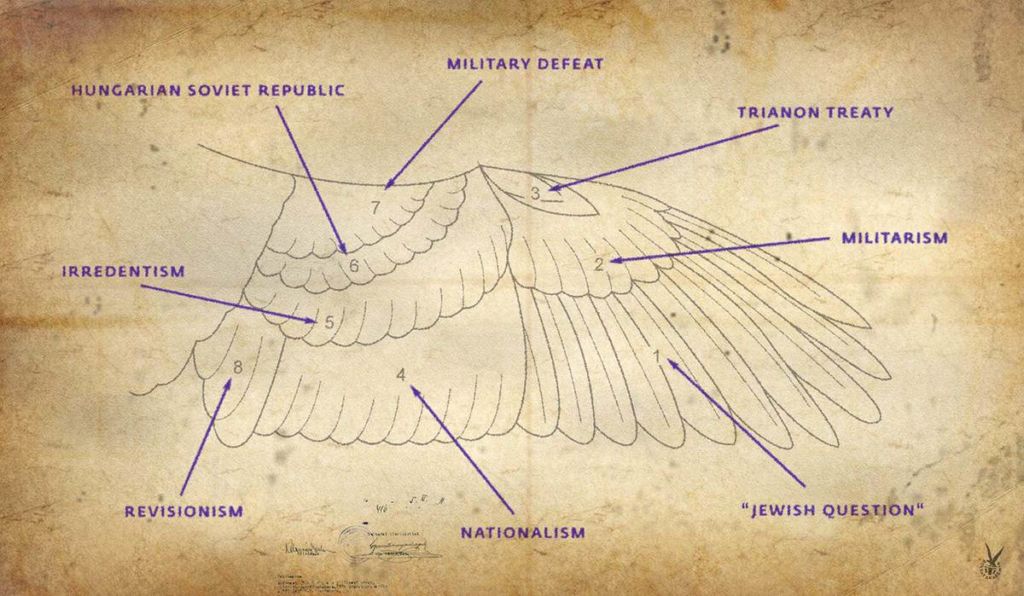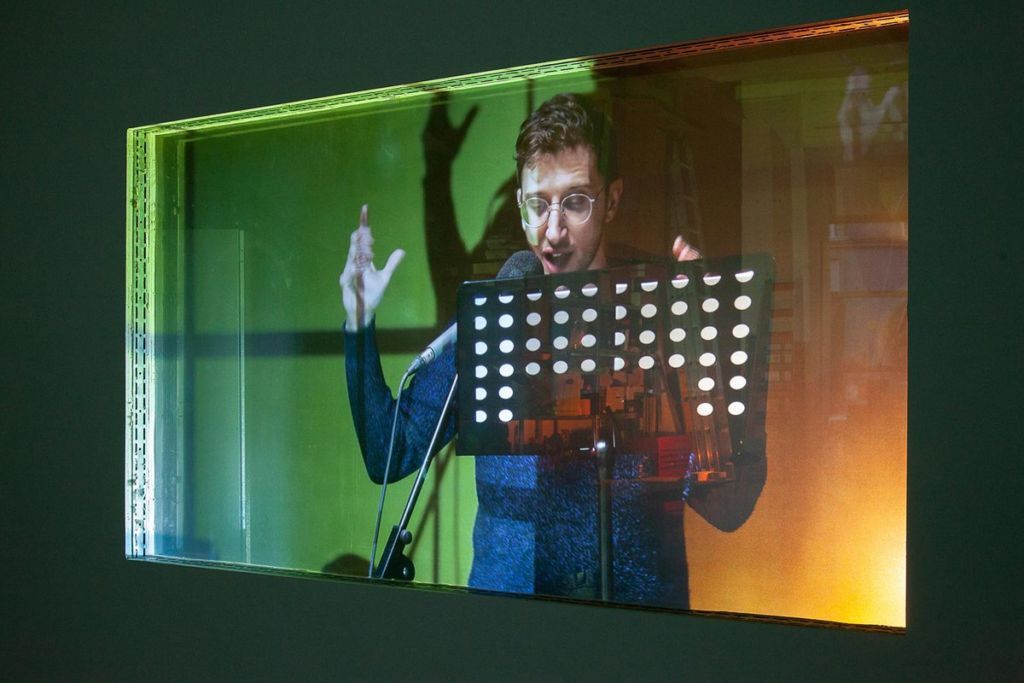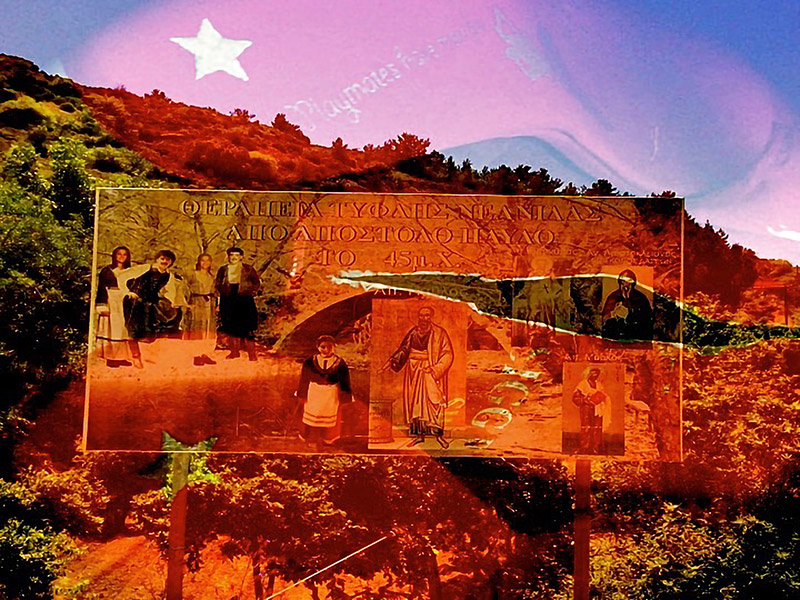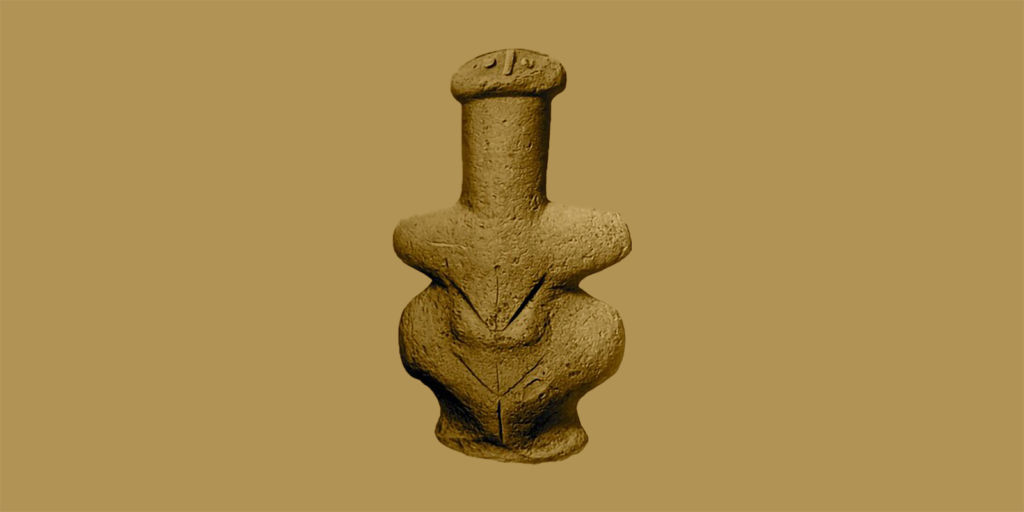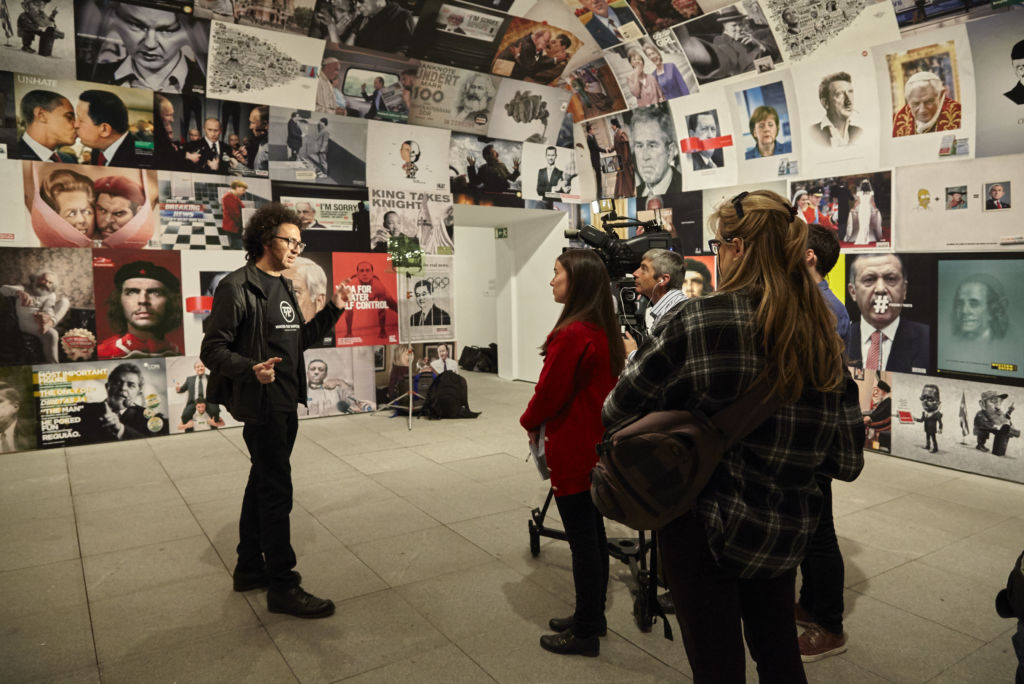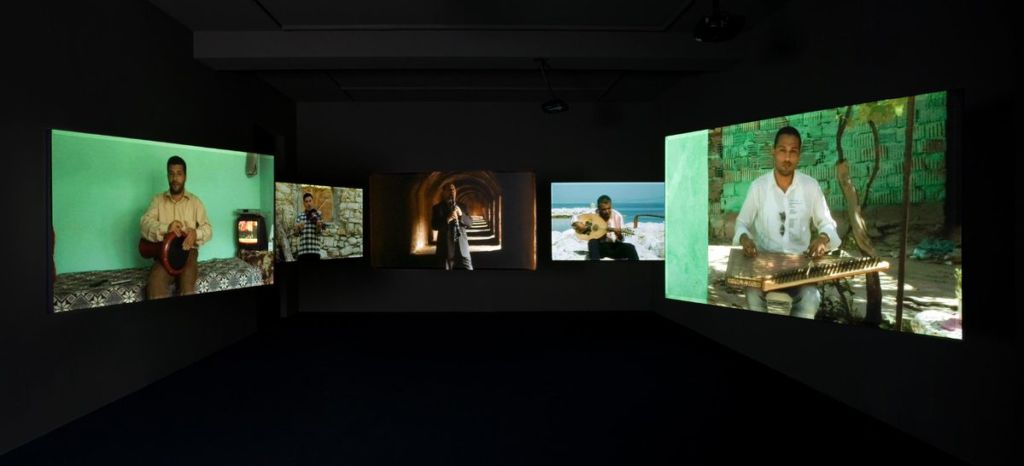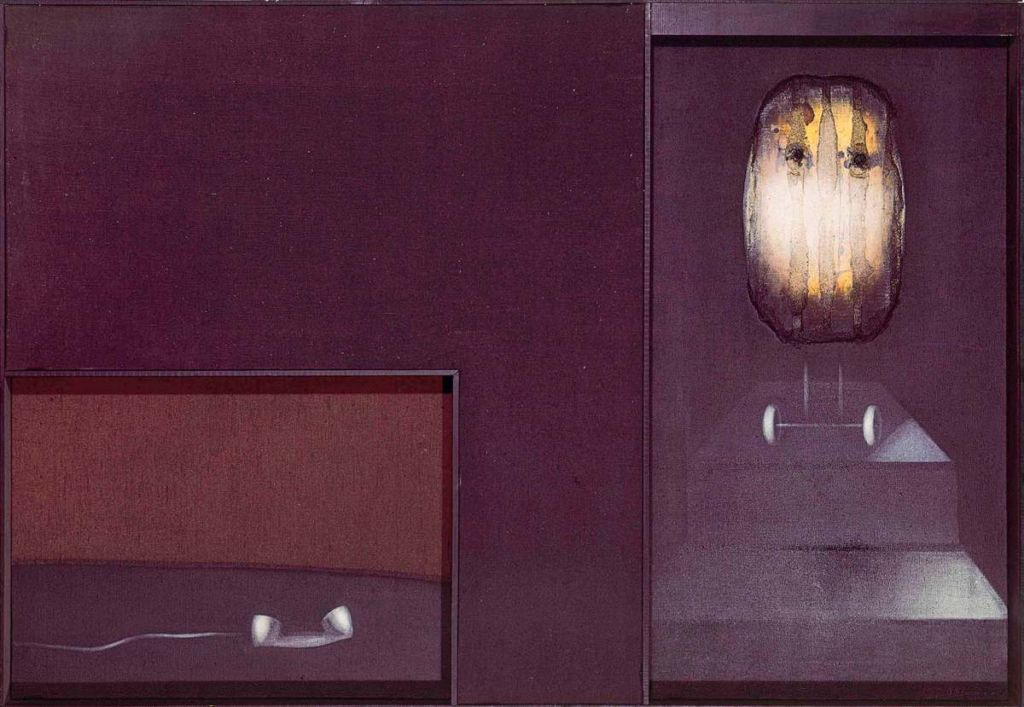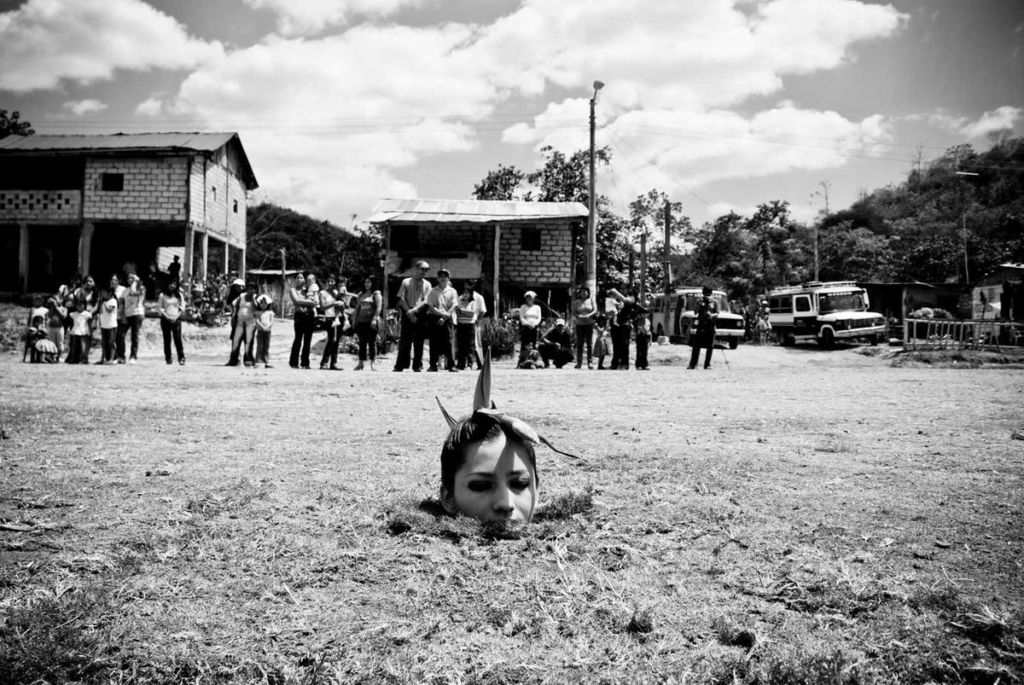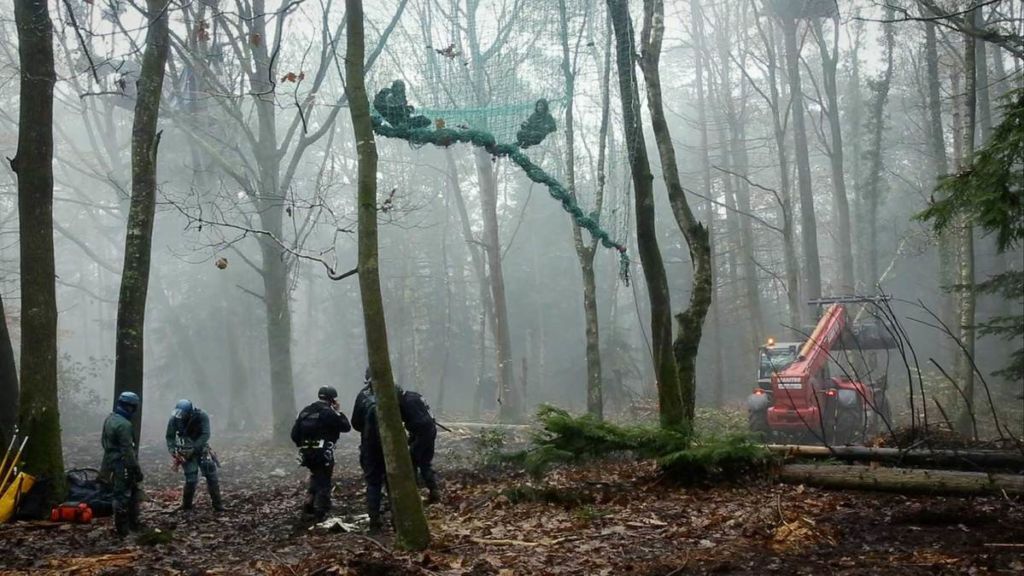Staging identity: the fictitious archaeological museum of Szabolcs KissPál
Investigation by Ágnes Horváth
At the end of 2017 in Budapest, the artist Szabolcs KissPál presented his Hungarian Trilogy, a prolific project which still today sheds a singular light on Viktor Orbán’s Hungary, a century after the trauma of the Treaty of Trianon which signed the dismantling of Austria-Hungary. Under the guise of a historical retrospective bringing together documents, objects and films retracing the painful history of the country in the 20th century, the exhibition cleverly blurs the lines, mixing the true and the false, to expose the difficult legacy of a nation haunted by deep wounds.
Baptised From Fake Mountains to Faith (Hungarian Trilogy), Szabolcs KissPál’s exhibition presented in five European cities1, is comparable to the highly dramatic psychological novel dear to Stendhal, Dostoyevsky or Kafka. It takes place in three acts, more precisely three juxtaposed scenes or tableaux built around three central pieces. The first is a video, entitled Amorous Geography [Szerelmes földrajz], which depicts the fake mountain at Budapest Zoo; the second, called The Rise of the Fallen Feather [A lehullott toll felemelkedése], evokes the resurgent cult of the Turul, the mythical bird at the source of Magyar identity, and of Turanism, a political ideology dear to Turkish nationalism and to Hungary in the late 19th century; finally, the third, entitled The Chasm Records [Szakadéklelet], brings together a collection of texts and documents, some of which were genuinely found or taken from archives and others, literally created from scratch.
The symbolic dimension of the exhibition venue
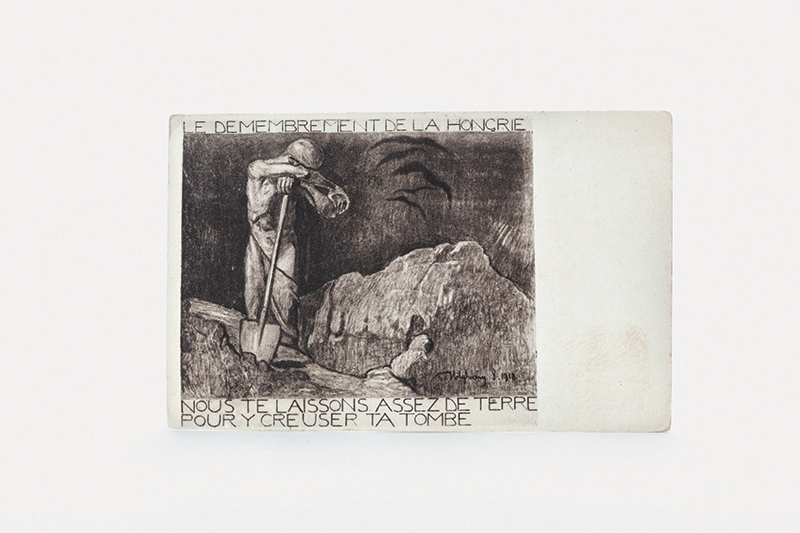
Szabolcs KissPál, Chasm Records, Revisionist postcard (1920), photo Zsuzsanna SImon
The Budapest Institute of Political History, which hosted the exhibition at the end of 2017, overlooks the tentacular and unsightly rococo parliament building, built during the preparations for the Millennium, the “official festivities” held in 1896 to celebrate the thousandth anniversary of the conquest of the Magyar country by the Hungarians in 895. It so happens that the Institute, a symbol of modernity, is in danger of being expelled from the premises, giving way to the Curia, due to replace the Supreme Court established in 1949. The Curia’s name dates back to the inter-war parliament governed by the vengeful Miklós Horthy, regent of the Hungarian Curia between 1920 and 1944, a figure for whom the current political right and extreme right make no secret of their nostalgia.
The very title of the exhibition, From Fake Mountains to Faith, poses the problem from the outset. The whole idea of erecting a mountain proves to be just as fallacious and archaic as the idea of elevating politics to the rank of religion, and thus making it sacred. The windows of the Institute of Political History offer us a privileged view of the Parliament, where terrifying laws are currently being crafted in a chain reaction that is gradually breaking down Hungary’s nascent democracy. In the exhibition halls, visitors are greeted by photos, videos, objects and texts in runic writing, testifying to a desire to represent a deep-seated sense of Hungarian-ness. The rune type is that of the Székelys people whom the Hungarians – wrongly – consider to be their authentic ancestors, and who led a life essentially based on shared traditions within a self-sufficient community.
The historical background: why the Székelys? Transylvania? Paganism?
The answer to the last question is very simple: those who today maintain the pagan trend, which is so attractive to the Hungarian conservatives currently in power, are unquestionably opponents of the West, and particularly of Europe. The resentment goes back to St. Stephen, the first Hungarian king and founder of the country, who had to convert to Christianity by yielding to Western pressure, thus renouncing the Hungarians’ ancestral ties with the East. Hence the spread of Turanism, a movement born in the 19th century which sought to reunite all Turkish-speaking peoples, including – Attention please! -Hungarians, in a single entity. The pagan ancestral current, representing original Hungarian-ness, was at that stage only a subculture, albeit a vibrant one. The cult of Székely and Transylvania is based partly on nostalgia and partly on historical facts. The Székely people are Hungarian-speaking and therefore have their own script, the famous Hungarian runes. They have long enjoyed privileges and have taken up the cause of Hungarians in Hungary on many occasions – in 1848 during the revolution and war for independence against the Habsburgs, in 1956 during the uprising against the Soviet regime, or in 1990 with the fall of the Communist Bloc. But, above all others, it is Transylvania, with its singular culture, that symbolises the essential aspirations of a state to reach autonomy. During the Turkish occupation, from 1541 to 1699, it formed a separate entity, although beholden to the Sultan. A few decades later, under Habsburg rule, the principality of Transylvania obtained a form of autonomy. It has often been associated with a kind of Arcadia because of all the tales and legends associated with it, starting with those written by the Hungarian writer Zsigmond Móricz. This explains the trauma caused by the signing of the Treaty of Trianon. Ratified in 1920, the Treaty of Trianon made official the dissolution of Austro-Hungary at the end of the First World War, and led to the loss of two thirds of the country’s territory, including Transylvania. A region that still has more than a million inhabitants who declare themselves Hungarian, a phenomenon that can also be seen, although to a lesser extent, in Slovakia and Transcarpathia.
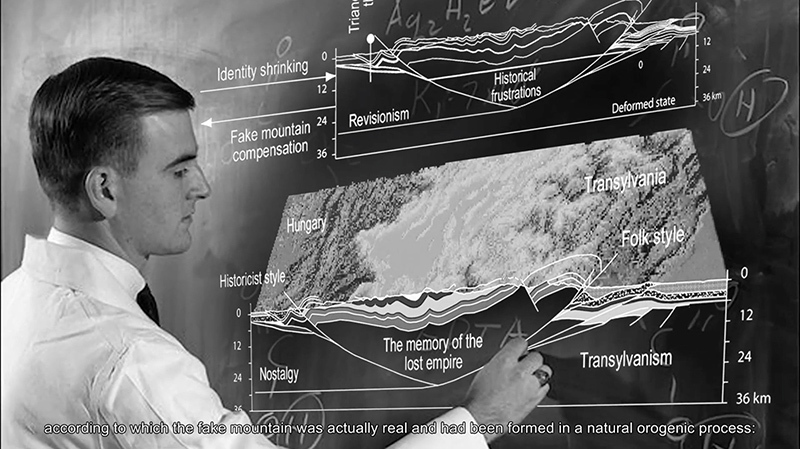
Szabolcs KissPál, Amrous Geography, 2016, videostill © Szabolcs KissPál
The artist’s conception – the artistic backdrop
The exhibition designed by Szabolcs KissPál is based on three notions: fictional archaeology, the museum as narrative and the mixture of reality and fiction. Ever since museums have existed, roughly since Napoleon transformed the Louvre Palace, they have amassed treasures in the form of collections of objects that had never before been displayed together. Their arrangement constitutes a kind of narrative based on real facts or on the curator’s imagination. Of course, this arrangement may or may not be credible, and the museum narrative can shift entirely into fiction. An even greater step can be taken – and this is KissPál’s trademark, one might say – towards fictional archaeology. If an exhibition can lie, if, by the way in which it is arranged, it is possible to involve real objects in a fake mise en scène, then why not actually fabricate fictitious objects? This opens up a new paradox: doesn’t an object cease to be fictitious once it begins to exist? The artist sets other traps for the visitor. Both videos begin with the characteristic fairy tale formula, “Once upon a time…”, but the images are almost all authentic documents. As the storyteller’s voice recounts “Once upon a time there was a country called Hungary”, our ears ring with the refrain from a song, which starts with “You are beautiful, you are wonderful, Hungary, more wonderful than the grand world”.
Prologue to the exhibition – The Chasm Records
The prologue to the exhibition explains that the objects [presented in the exhibition] “were found at 56 metres2 from each other, separated by a small ravine therefore named Chasm Records. They consist of an ammunition box and a backpack with a first aid kit box”.
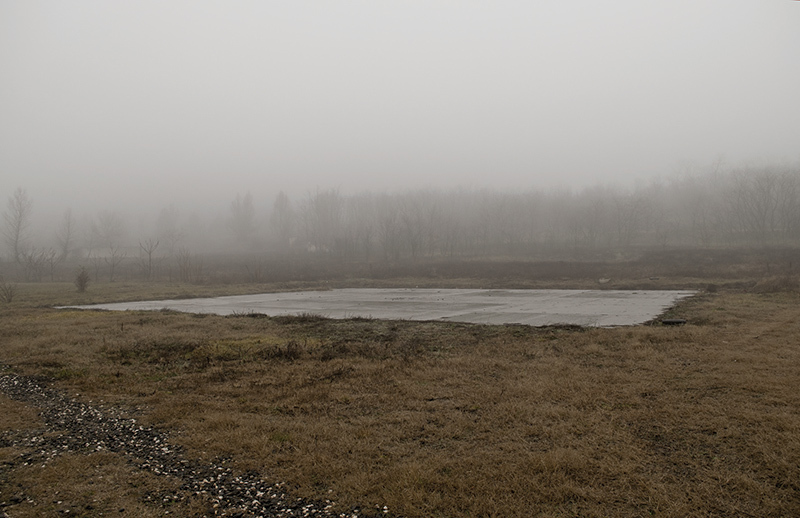
Szabolcs KissPál, From Fake Mountains to Faith, Shooting range Piliscsaba, 2016 © Szabolcs KissPál
It is through Tamás, the owner of the backpack, that all the discoveries are linked to what could be called the “inner voice” of the exhibition.
The wall text continues the narrative, mixing reality and fiction: The backpack “originally belonged to a British WAAF (Women’s Auxiliary Air Force) unit. According to a diary fragment, this item was given toTamás in June 1944 by Yoel Palgi, a Jewish partisan from the British Mandate of Palestine, who was born in Transylvania. The backpack might have belonged to Palgi’s comrade, Hanna Szenes, a paratrooper of the WAAF. She was a young Jewish poet, who, after becoming a partisan, was parachuted into Yugoslavia in May 1944 to assist in the rescue of Hungarian Jews. She was arrested, imprisoned and tortured, and eventually tried and executed by firing squad”.
Among The Chasm Records is a postcard addressed by Tamás to Sárika Rosemberg, a Jewish girl from the town of Celldömölk (Hungary). It was mailed on August 22, 1920, a few weeks after the signing of the Treaty of Trianon and before the introduction in Hungary of the first Anti-Jewish Act of 20th century Europe. This irredentist postcard is illustrated on the front with a dramatic drawing of a man digging his grave. The text on the card reads: “Just enough earth left where to dig your grave”. The message in pencil reads: “Dear Sárika, I got back to Budapest in safety. However in 3-4 days I have to continue my journey. I recall with great pleasure the memories of you all. I hope we won’t be resentful to each other…?”
Behind this love story between two fictional characters, the path of the whole exhibition is traced out.
The key phrase here is “I hope we won’t be resentful to each other?” (Remélem, nem leszünk haragosok.). The Hungarian word “haragos” refers to those who fought each other, the enemies. It refers to the opposition between Hungarian/Aryan/Christian and non-Hungarian/Jewish. It is up to Tamás alone to take Sárika’s side or not. But Tamás’ dilemma also implies that Sárika will always love him and that there might be a marriage at stake. Seen from today’s perspective, the question seems dramatic and universal, but set in the context of the horrors of the 20th century, it is even more so. One can sense the dawning of this – legitimate – anguish which, formulated in a crude and slightly caricatured way, could lead to the following question: “Does [this treaty of] Trianon make you, a young Jewish girl, suffer as much as I do? It is this famous obsessively resonating “inner voice” that seems to express his affliction, but in a somewhat stifled manner.
The front and back of this sinister postcard, the former displayed as you enter the exhibition, and the latter as you leave, depict the tragic historical trajectory of the country from its birth to the end of the first half of the 20th century.
On the subject of fake objects – Amorous Geography
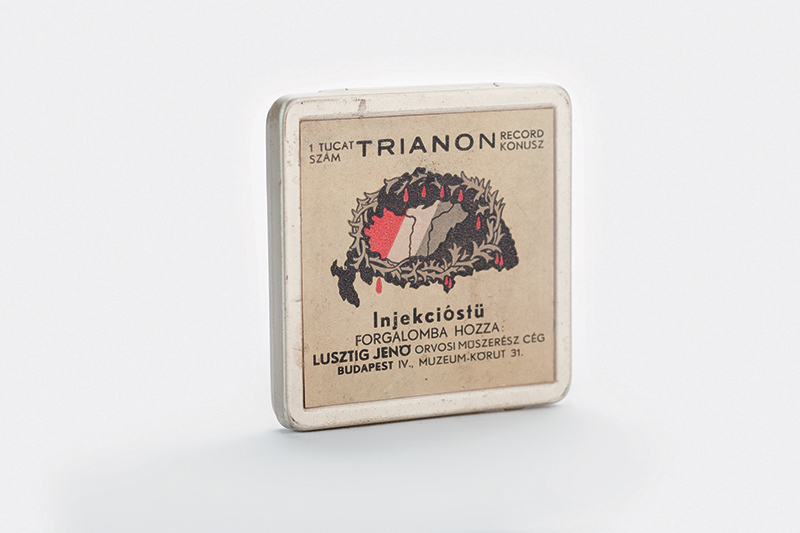
Szabolcs KissPál, Chasm Records, “Trianon” hypodermic needle (1930s), 2016, photo Zsuzsanna Simon
A tasty example of a fake object is the Great Rock, the artificial mountain that still stands today in Budapest Zoo and to which the title of the exhibition refers. A commission to redesign parts of the zoo was granted to Székely architect Károly Kós, of German-Austrian-French origin and future inventor of Transylvanianism. The idea of an artificial mountain was inspired by the German Carl Hagenbeck, who wanted to remove the cages separating visitors and animals so that the animals could be observed in a simulated natural environment. Although fake, the mountain needed a natural and historical model. The first idea was Mount Ararat (where, according to the Old Testament, Noah’s Ark would have landed), followed by Mount Sinai (where, again according to the Old Testament, Moses received the tables of the law), and Mount Everest (the highest peak in the world). But in the end the choice fell on Lonely Rock [Egyes-kő] in Transylvania – a Hungarian mountain. The fake mountain became part of reality. The video Amorous Geography tells us that, according to some rumours, it was thrust up out of the earth when the country was shrunk to a third of its size after Trianon: the geopolitical shock following the treaty allegedly produced an earthquake that caused it to emerge. The film’s commentary goes on to say that, during the zoo renovations, an inscription was found inside the mountain, engraved in Hungarian runes. A specialist was called in urgently to decipher it, but both the text and the specialist disappeared. Later, a document was found in the pocket of one of the specialist’s clothes, with the words: “Fuck your fake mountains!”
The items on display in the exhibition and the story they weave are in fact fake, but the historical context they evoke is far from being so. The text reads: “The records presented here have been found in the Pilis Mountains, (Northern Hungary 756 metres), considered a sacred site by non-academic Hungarian historiographers and “sacral geographers”. For many Hungarians, the mountain thus represents the place where their national identity takes root.
For the English poet William Blake, moreover, mountains, real ones, are the promise of a brighter future: “Great things are done when men and mountains meet.” (Satirical Verses and Epigrams).
Just as the zoo’s fake mountain gave rise to at least two myths, the clock – a work by KissPál, whose tick-tock resounds as you enter the exhibition – appears to reach the height of fantasy: its shape is that of Greater Hungary, pre-Trianon Hungary. With the change of regime in 1990, the map of Greater Hungary, declared illegal under the pseudo-socialist regime of János Kádár, resurfaced on the political right, and became a symbol of pain and loss, the nostalgic mourning of a “glorious” past. In the centre of the dial, the emblem of the Treaty of Trianon – a cross – shines like a torch. And the hands turn anticlockwise, foreshadowing the backward-looking nature of the tour we are about to take.
How hollow this cheap past sounds, built on lamentations!
Trianon, Ady, “We need a Mohács”

Szabolcs KissPál, Chasm-Records, Wall clock (21st century), 2016, photo Zsuzsanna Simon
In the national imagination, Trianon soon merged with another debacle, the Battle of Mohács which in 1526 marked the end of the independent, autonomous kingdom of Hungary of Medieval times. Then came Turkish occupation, followed by absorption into the Habsburg Empire. The romantic nationalism of the 19th century made this defeat the national symbol of mourning and historical catastrophe. In the 20th century, through the thoughts and writings of the Hungarian poet Endre Ady, the omen of Mohács was transformed. A poem from 1908, We need a Mohács, deploys its symbolism:
If there’s a God, may he have no mercy on’t:
It’s used to beating and want,
Among limp-hearted nations a gypsy kit,
Let him just beat it, beat it.
If there’s a God, give me scorn with a flout:
I’m a Magyar out and out.
Let not His holy dove bring me branches fresh,
Let Him beat me, flail and thresh.
If there’s a God, from the earth to heavens fair
Let Him drag us by the hair.
Let us not get a minute to peace attuned,
Otherwise we’re doomed, we’re doomed3.
In this poem, Mohács is no longer just a national disaster, it becomes the emblem of the guilty impotence of the Hungarian people.
There are two wounds that we cannot heal: Mohács and Trianon. Neither the First nor the Second World War caused the vast majority of Hungarians to suffer like these two wounds. Although we have recovered from Mohács, Trianon remains the symbol of defeat, and its political consequences are still being felt today.
On the occasion of the 100th anniversary of the Treaty of Trianon, KissPál suggested installing a vase in the Galerie des Cotelle in Versailles, where the treaty was signed, holding flowers to symbolise each of the peoples involved. The tulip was to represent Hungary, the rose Slovakia, the Ramonda Nathaliae Serbia, etc. Visitors could have watered and admired the flowers as their moods dictated. The fact that the Galerie des Cotelle serves as a shelter for the flowers of the Great Garden in winter enhances the beauty of this idea. It also expresses the desire for everlasting peace in the “Make love, not War” slogan of the 1960s. But the curators of the Château de Versailles did not see things in the same light. They rejected the project on the grounds that the concept was not in keeping with the museum’s profile.
Trianon, Turul, Turanism
The exhibition is also built around three T’s. Not those of the political system established by Kádár, Támogatott (supported), Tűrt (tolerated), Tiltott (forbidden), which regulated the arts by dividing them into three groups. But the three T’s of post-Kádárism: Trianon, Turul, Turanism. Trianon: the historical catastrophe, the new Mohács, defeat, the everlasting “Something bad always happens to us, but we can’t do anything about it”. The Turul would be the cure for our troubles. This bird of Hungarian legends, “resurrected” by nationalist historiography in the 19th century, is the sacred bird, the totemic animal of the Hungarians, the ancestor, the blessed bird that brought us to this “Holy Motherland”, to this dear land of the Carpathian Basin. Turianism reinforces this image, cherished by the extreme right, which endows Hungarians with one hundred percent Turkish origin.
The video The Rise of the Fallen Feather reveals the permanence of Turanism in Hungary and the myths of blood and land, always blending reality and fiction. It tells how, in the age of speed, the Millennium celebrations were organised, symbol of a distant and feudal era. In 1902, a hot-air balloon named Turul was launched on a flight to the United States, while in 1931 a plane, bearing the inscription “Justice for Hungary” was launched from Canada4. The fuel ran out and the plane crashed in Felcsút, birthplace of the current Prime Minister Viktor Orbán, a town generously endowed with, among other things, a huge and disproportionate stadium. But the docu-fiction continues. Ten years after September 11, 2001 – the catastrophe that served as a revelation of the vicissitudes of our times – the Hungarian government organised a Turul-launching event. The feathers of the sacrosanct birds disappeared in full flight, but the relentless search for them continued, until they were discovered in the ground during the construction of the same stadium in Felcsút. To celebrate the event, a totem pole was erected in the heart of the country, in Ó-Pusztaszer, which the Hungarian Prime Minister inaugurated with the following words – chilling for many of us: “The Turul is the archetype of Hungarians (…). The archetype belongs to blood and motherland5. As soon as we came into the world, our seven tribes made an alliance, our Saint Stephen founded a state, our armies lost a battle at Mohács; while the Turul bird is the symbol of the national identity of the Hungarians of today, yesterday and tomorrow”.
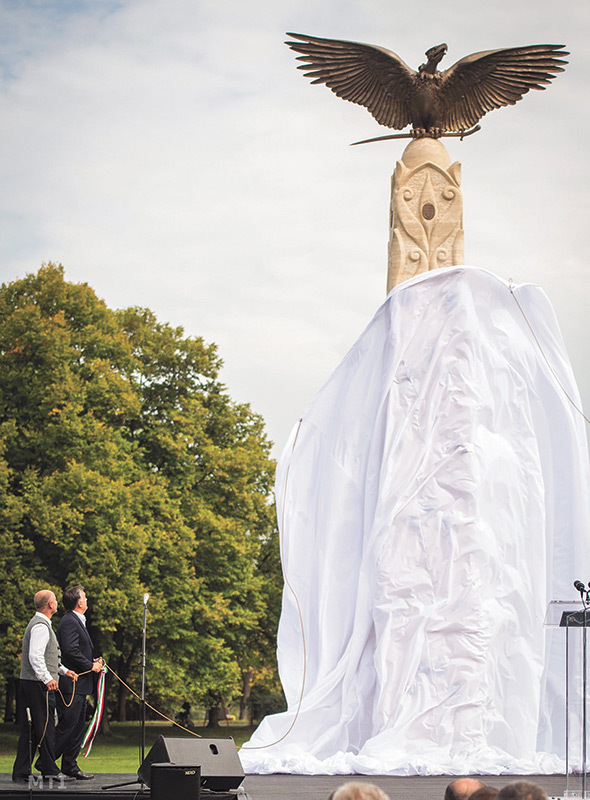
Szabolcs KissPál, PM Orbán unveiling a Turul monument, 2012, photo Tibor Illyés/MTI
The entire exhibition speaks of the lack of freedom, or even the destruction of freedom, which can generate endless resentment. The businessman, billionaire and philanthropist György Soros, currently presented as Hungary’s number one public enemy, not least because he built his fortune in the West, recently wrote on the occasion of the celebration of the hundredth anniversary of the birth of Miklós Vásárhelyi, the 1956 fighter and first president of the Soros Foundation in Hungary: “Love gives birth to the future, hatred to the false past”.
Throughout the exhibition, beyond the triumphant ethnic myth and the growing desire for the nation to seek its path, one sees the clouds gathering over the Jews of Hungary, little by little. Clouds all the darker for having been smothered at the time. The clouds have broken today, with official statements like that of Szilárd Demeter, Viktor Orbán’s cultural adviser, referring to Europe as a “gas chamber”. As another sign of this ambivalent relationship, the artist recalls the gesture of the Jewish architect Dezső Freund, designer of the Nagyfuvaros Street synagogue in Budapest. He had the Hungarian declaration of faith inscribed on its façade: “I believe in one God, I believe in his one and only homeland: I believe in divine eternal justice, I believe in the resurrection of Hungary!
Amen”.
One showcase in the exhibition remains empty, in spite of being numbered. It will doubtless be occupied by a worthy object one day. This vacant space, signifying “in case I’ve forgotten something”, is also part of the dialectical and critical thinking of the exhibition.
Translated from the Hungarian to French by Virginie Sette
Translated from French to English by Angela Kent
Edited by Vincent Simon
Cover: Szabolcs KissPál, The Rise of the Fallen Feather, 2016, videostill, copyright by the artist
1.Presented under its English title: From Fake Mountains to Faith (Hungarian trilogy), the exhibition was first shown at the Edith Russ Haus für Medienkunst, Oldenburg, Germany, in 2016, at Transit RO, Cluj, Romania, in 2016-2017, at the Project Arts Centre, Dublin, Ireland, in 2017-2018, at Kostka Galleria – Meetfactory, Prague, Czech Republic, in 2017, and finally at the Institute of Political History in Budapest, from 10 October to 3 November 2017.
2.Alluding to the 1956 uprising.
3.We need a Mohács [Nekünk Mohács kell, in Összes versei, 179. Athaeneum, 1913], translated from Hungarian to English by István Cziegler.
4.Canada is not an innocent choice. It is the country that welcomed the most Hungarians after the 1956 uprising.
5.An echo of the sinister Blut und Boden that characterised Nazi ideology.
